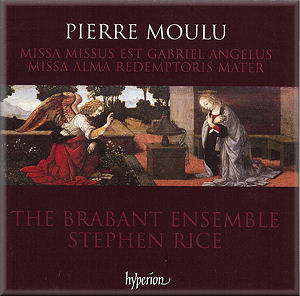 |
 |
|


alternatively
CD: AmazonUK
AmazonUS
|
Pierre MOULU
(1484?-c.1550) Mater floreat [5.41]; Missa Missus est Gabriel
angelus [25.14]; In Pace [8.52]; Missa Alma redemptoris mater [22.50];
Kyrie (Missa Alma redemptoris mater), long version [2.49]; Agnus
Dei (Missa Alma redemptoris mater), long version [5.01]
Josquin DES PREZ (c.1450/55–1521)
Missus est Gabriel angelus [4.09]
 The Brabant Ensemble/Stephen Rice
The Brabant Ensemble/Stephen Rice
rec. Chapel of Harcourt Hill campus, Oxford Brookes University,
4-6 September 2009
 HYPERION CDA67761 [74.38]
HYPERION CDA67761 [74.38] 
|
|
|
Not a lot is known about Pierre Moulu. Petrus Moulu is mentioned in a document in the Vatican; this Petrus Moulu was a cleric in the diocese of Meaux and was 21 in 1513. This is probably the composer of the five mass settings, twenty motets and ten chansons which date from the second and third decades of the sixteenth century. His music seems to have attracted the attention of his contemporaries as his works appear in numerous contemporary manuscripts. Pierre de Ronsard described Moulu as a disciple of Josquin, but no firm documentary evidence can be found for this.
His most famous work is his Missa Alma redemptoris mater and it has attracted considerable attention from musicologists. This is because at the top of the score the composer has placed a rubric which says that if you want to shorten the mass, then omit the longer rests. So that effectively the piece exists in two versions. In sixteenth century part books, where each part is notated separately, it is possible to perform either version from the same score, simply missing out the rests. Modern scores however need to be notated separately. But Moulu's notation seems to have caused some confusion with copyists, as he had to use special symbols to indicate where parts finish in the short version as omitting rests means that the different voices end up with parts of differing lengths. For their new recording of the mass, the Brabant Ensemble give the short version complete and add the long version of the Kyrie and Agnus Dei. These are taken from an alternative manuscript and so differ in small details from the short version. In the long version, the Kyrie expands from 2.08 to 2.49 and the Agnus Dei from 3.37 to 5.01
Moulu's style is substantially relaxed and contemplative, so the difference between the short and long versions is not great. But the shorter versions seem to be a little more urgent and contain a greater number of dissonances. It is a great tribute to the fascination of the sixteenth century musicians with mathematics that both versions of the mass work so well, each seeming complete and perfect in its own right.
Moulu's motet Mater Floreat is another puzzle work. It belongs to another speciality genre, that of the musician motet, whereby the text includes the names of contemporary musicians. Moulu's motet includes just about everyone who flourished internationally at the time. Though the list includes many musicians active in Paris, Moulu does not himself seem to have been. It is convincingly argued that the puns in Mater Floreat belong more suitably to an entertainment written at Meaux. But in that case, why does the motet survive in a single manuscript which was presented to Lorenzo de Medici at his wedding in 1518? No-one knows.
The motet itself is a charming piece whose musical content rather belies the skittish nature of the words, using a forthright and declamatory style to highlight the names of the composers. His setting of the compline responsory In pace is more contemplative, with long melismatic lines, the two tenor parts performing a slow canon and the other three parts weaving around them.
Moulu's Missa Missus est Gabriel angelus is based on a short motet by Josquin and this is the closest that Moulu's style comes to that of the older composer. Moulu's setting has a reflective and austere beauty which at times echoes Josquin. The group also include the original Josquin motet, so that listeners can decide for themselves how close the ties were between the composers.
The Brabant Ensemble are an eleven-voiced choir, using female altos and sopranos. They sing with a lovely clear, focused tone which allows the polyphony space to flourish and each line is clearly delineated. They sing the Latin with a form of French pronunciation which is entirely suitable for this composer.
Moulu is not a showy writer. Stephen Rice and his ensemble allow the composer's distinctive reflective voice to come over in these fascinating and rather enchanting pieces.
Robert Hugill
|
|

